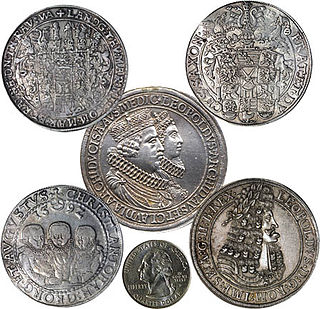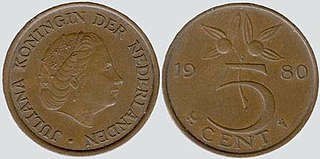See also
- Dalader, a genus of coreid bugs
| This disambiguation page lists articles associated with the title Daalder. If an internal link led you here, you may wish to change the link to point directly to the intended article. |
Daalder may refer to:
| This disambiguation page lists articles associated with the title Daalder. If an internal link led you here, you may wish to change the link to point directly to the intended article. |

Dollar is the name of more than 20 currencies. They include the United States dollar, Australian dollar, Canadian dollar, Hong Kong dollar, New Zealand dollar, Singapore dollar, New Taiwan dollar, Jamaican dollar, Liberian dollar, Namibian dollar, Brunei dollar, and several other.

A thaler is one of the large silver coins minted in the states and territories of the Holy Roman Empire and the Habsburg monarchy during the Early Modern period. A thaler size silver coin has a diameter of about 40 mm (1½") and a weight of about 25 to 30 grams, or roughly 1 ounce.

The Spanish dollar, also known as the piece of eight, is a silver coin of approximately 38 mm (1.5 in) diameter worth eight Spanish reales. It was minted in the Spanish Empire following a monetary reform in 1497. It was widely used as the first international currency because of its uniformity in standard and milling characteristics. Some countries countersigned the Spanish dollar so it could be used as their local currency.
Schelling is a surname. Notable persons with that name include:

The Reichsthaler was a standard Thaler silver coin of the Holy Roman Empire, established in 1566 by the Leipzig convention. This original Reichsthaler specie was supplemented in the 16th century by various Reichsthaler units of account in northern Germany in the 17th century and by a Prussian Reichsthaler coin in 1750.
The Dutch guilder or fl. was the currency of the Netherlands from the 17th century until 2002, when it was replaced by the euro. Between 1999 and 2002, the guilder was officially a "national subunit" of the euro. However, physical payments could only be made in guilders, as no euro coins or banknotes were available. The Netherlands Antillean guilder is still in use in Curaçao and Sint Maarten, but this currency is distinct from the Dutch guilder. In 2004, the Surinamese guilder was replaced by the Surinamese dollar.

The stuiver[stœy.vər] was a pre-decimal coin used in the Netherlands. It was worth 16 penning or 8 duit. Twenty stuivers equalled a guilder. It circulated until the Napoleonic Wars. After the conflict, the Netherlands decimalised its guilder into 100 cents. Two stuivers equalled a dubbeltje - the ten-cent coin.

The Netherlands Antillean guilder is the currency of Curaçao and Sint Maarten, which until 2010 formed the Netherlands Antilles along with Bonaire, Saba, and Sint Eustatius. It is subdivided into 100 cents. The guilder was replaced by the United States dollar on 1 January 2011 on Bonaire, Saba and Sint Eustatius. On Curaçao and Sint Maarten, the Netherlands Antillean guilder was proposed to be replaced by a new currency, the Caribbean guilder, but this has been stalled indefinitely by negotiations over the establishment of a separate central bank for Curaçao.

The duit was a copper Dutch coin worth 2 penning, with 8 duit pieces equal to one stuiver and 160 duit pieces equal to one gulden. In Dutch Indonesia 4 duit pieces were equal to one stuiver. To prevent smuggling, the Dutch East India Company (VOC) ordered special coins with their monogram embossed upon them. Only those pieces were valid in Indonesia. It was once used in the Americas while under Dutch rule.

The rijksdaalder was a Dutch coin first issued by the Republic of the Seven United Netherlands in the late 16th century during the Dutch Revolt. Featuring an armored half bust of William the Silent, rijksdaalder was minted to the Saxon reichsthaler weight standard – 448 grains of 0.885 fine silver. Friesland, Gelderland, Holland, Kampen, Overijssel, Utrecht, West Friesland, Zeeland, and Zwolle minted armored half bust rijksdaalders until the end of the 17th century.

The rixdollar was the currency of British Ceylon until 1828. It was subdivided into 48 stivers, each of 4 duit. Units called the fanam and larin were also used, worth 4 and 9½ stiver, respectively. The currency derived from the Dutch rijksdaalder and stuiver, although the rijksdaalder was worth 50 stuiver. The rixdollar was replaced by the British pound at a rate of 1 rixdollar = 1 shilling 6 pence.

The gulden was the unit of account of the Dutch East Indies from 1602 under the United East India Company, following Dutch practice first adopted in the 15th century. A variety of Dutch, Spanish and Asian coins were in official and common usage. After the collapse of the VOC at the end of the 18th century, control of the islands reverted to the Dutch government, which issued silver 'Netherlands Indies' gulden and fractional silver and copper coins until Indonesian independence in 1949.
The guilder was the currency of British Guiana between 1796 and 1839.
Rene Daalder was a Dutch writer and director. He lived in Los Angeles. Originally a protégé of Russ Meyer, Daalder has worked with Jan de Bont, Frans Bromet, and Rem Koolhaas.

The Exchange Bank of Amsterdam was an early bank, vouched for by the city of Amsterdam, established in 1609, the precursor to, if not the first, modern central bank.
The reaal was the currency of Curaçao until 1828. It was subdivided into 6 stuiver, with 20 stuiver equal to the Dutch gulden.
The ducaton, ducatone or ducatoon was a crown-sized silver coin of the 16th-18th centuries.

Cornelis Molenaer or Cornelis Molenaar (born c. 1540 - 1589 was a Flemish Renaissance painter known for his landscapes with biblical scenes.

A dubbeltje is a small former Dutch coin, originally made of silver, with a value of a tenth of a Dutch guilder. The 10-euro-cent coin is currently also called a dubbeltje in the Netherlands.

Tetraena stapfii is a species of flowering bush endemic to Namibia.